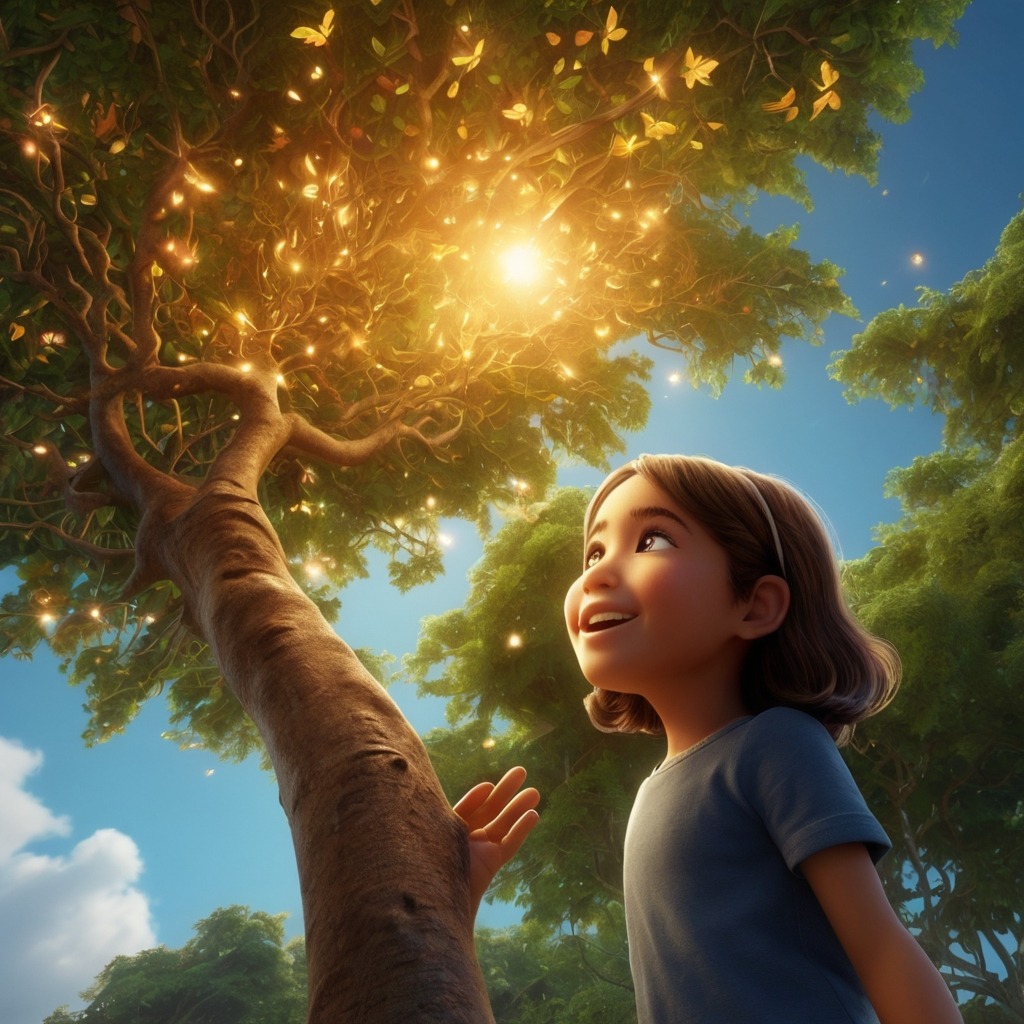In a peaceful village full of fields and laughter, little Tara discovers a magical tree that only speaks to kind-hearted children.
Introduction:
Village life brings children closer to nature, community, and simple joys. In Tara and the Talking Tree of Tamarind Village, young readers get a taste of village charm, kindness, and the magic of listening to nature. This heartwarming story inspires respect for the environment and others.
Full Story:
Tara lived in Tamarind Village, a small place surrounded by green fields, chirping birds, and the smell of fresh rain.
Everyone in the village knew Tara—curious, barefoot, and always asking questions.
She loved exploring, but her favorite spot was a big old tamarind tree near the pond. Its long branches swayed in the breeze like arms waving hello.
Every day after school, she’d sit under its shade, do her homework, and watch the ducks in the pond.

But one day, something incredible happened.
The Tree Speaks
It was a quiet afternoon. Tara sat alone under the tree, humming a song her grandmother taught her.
Suddenly, she heard a gentle voice:
“That’s a lovely tune, Tara.”
Her eyes widened.
“Who said that?!”
“It’s me,” the voice replied.
Tara looked around—no one.
Then she looked up.
The leaves rustled gently, and the bark shimmered. The tamarind tree was talking!

The Tree’s Secret
“Are you… alive?” Tara asked in a whisper.
“I’m very much alive,” said the tree. “But I only speak to children who are kind to others and care for nature.”
Tara felt her heart bloom with joy. “Why me?”
“You return the fallen flowers to my roots. You water the little saplings nearby. You even stopped that boy from carving his name into my bark.”
Tara grinned. “I just love being here.”
Helping the Village
Over the next weeks, the tree told her stories about the village—how the pond was once a small spring, how her grandmother used to swing from its branches, and where the wild bees lived peacefully nearby.
But one day, trouble arrived.
A truck rolled in. Men with tools said, “We’ll cut this tree and build a parking lot.”
Tara ran to the village elders. “You can’t cut down the tamarind tree!”
“It’s too old, child,” they said. “Its time is over.”
Tara ran to the tree and cried, “What should I do?”
“Tell them what I’ve told you. Show them how I still protect, shade, and feed.”

Tara’s Plan
Tara made posters with drawings of the birds, squirrels, and bees living in the tree.
She asked her teacher if she could speak at morning assembly.
She told everyone how trees give oxygen, protect the soil, and carry memories of generations.
Soon, the villagers gathered.
Grandparents nodded. “This was where we played too.”
A farmer said, “The bees from this tree help pollinate my crops.”
Even the village head smiled. “Maybe we can build around it, not over it.”
The men with the truck left quietly.
A Living Legend
From that day on, the tamarind tree was called “The Guardian Tree.”

Tara became its little protector—and now, the tree whispered to her even more stories, about the stars, the rain, and the old magic of the village.
Moral:
Kindness to nature brings wisdom, friendship, and protection. One small voice can inspire a whole community to do the right thing.
Conclusion:
Tara and the Talking Tree of Tamarind Village captures the magic of rural life, showing children the power of compassion, nature, and community action. This charming tale encourages readers to be caretakers of the earth and champions of what matters—even if they’re still little.
Use this story during reading time, nature education sessions, or as an inspiration for environmental school projects.










7 responses to “Tara and the Talking Tree of Tamarind Village | Village Stories”
Awesome post! Join the fun at https://meucassino.org for up to R$1,000 welcome bonus, progressive jackpots, and instant PIX withdrawals. Date: 2025-11-16 20:45:11 (-03).
Awesome post! Join the fun at https://motagascassino.com for up to R$1,000 welcome bonus, progressive jackpots, and instant PIX withdrawals. Date: 2025-11-24 00:01:19 (-03).
Alright, looking for some fast slots for hours of fun? The slot games are a blast on bk88slot!! Lots of bonuses, and cool events to join! If you haven’t already tried it, click here: bk88slot
Guys, I was a bit skeptical at first, but bingoplus1legit is actually pretty decent! Smooth gameplay and haven’t had any issues cashing out. Give it a shot! Check it out here: bingoplus1legit
Clubgamelogin is pretty standard, but it does the job. Easy to get logged in and start playing. Nothing particularly outstanding, but nothing bad either. It’s a solid option if you’re looking for a basic gaming platform: clubgamelogin
Alright guys, just checked out km88abcvip – seems like a pretty solid spot for some online fun. The interface is clean and easy to navigate, which is a big plus in my book. Definitely worth a look if you’re looking for a new place to hang out. You can find it here: km88abcvip
Awesome post! Join the fun at https://kew-app-whats.com WhatsApp 网页版的动态功能,帮助用户展示实时状态更新。 . Date: 2025-12-05 17:59:17 (-03).